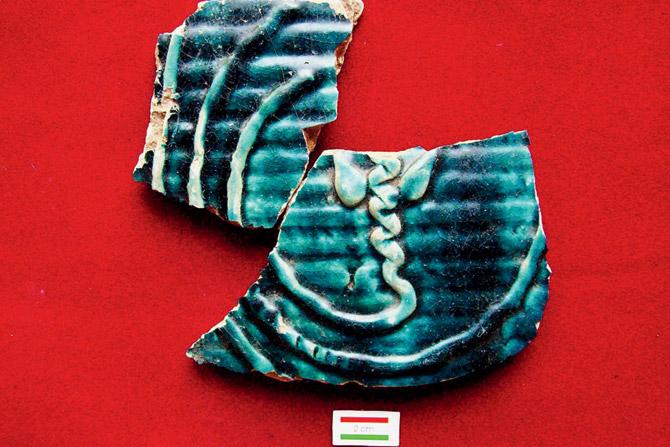A series of lectures by archaeologist Rukshana Nanji explores the arrival and integration of Christians, Muslims and Parsis in early medieval India

Glazed pottery from the excavations at Sanjan, dating to the 9th century CE. It is a trade ceramic of the early Medieval period and is found at most port sites in the Indian Ocean with Persian and Arab trade contacts. The Turquoise glazedware jar fragment
In the 21st century, while we equate the importance of religion with the number of concrete structures being built, archaelogist Rukshana Nanji goes back to simpler times. It-s the early medieval period — circa 7th to the 13th century — and being part of the Christian, Muslim or Zoroastrian community in India didn-t imply being treated as alien to the subcontinent. It means arriving, settling and making the country your home, in the truest sense of the word. "You-re looking at monotheistic religions integrating into a polytheistic country. Hailing from West Asia, they arrive via sea and settle by the ports. And the Indians welcome them. So, it wasn-t about religion as much as it was about culture," Nanji tells us, giving a gist of a series of lectures she will present at The K R Cama Oriental Institute this week.
As part of the Government Research Fellowship Lectures, Nanji-s paper is titled Ancient Shores, New People: The Arrival and Integration of Christians, Muslims and Parsis in Early Medieval India. Starting tomorrow, she will deliver three lectures — The Cross on the Coast: A brief Overview of the Christian Presence in Indian Ports chaired by Dr Fleur D-Souza, The Crescent and the Sea: The Arrival of Islam on Indian Shores chaired by Dr Mariam Dossal and The Flame in India: The Migration and settlement of Parsis in India chaired by Jehangir R Patel. The papers took about eight months to complete and the idea germinated from Nanji-s research work at Sanjan on the Parsi community.
ADVERTISEMENT

The lustreware bowl is from Basra in Iraq
"I found the theme to be interesting given what is happening in the country today. People are trying to convey the idea that Islam and Christianity were forced upon us and forget the maritime links the West Coast of India had with West Asia for many years," D-Souza remarks and Nanji concurs — although present-day narratives weren-t the inspiration for her. "In this period, I don-t think there were any possible signs of conversion. The minorities were politically not powerful enough," she says.
 Rukshana Nanji
Rukshana Nanji
Although there is no direct connect to Bombay with regards to the arrival of Muslims and Parsis, Nanji gives insight into how the city still fits into the equation. One can find a mention of Kalyan as an important port in an account by Greek merchant Cosmas Indicopleustes, in the middle of the 6th century.
"He also writes that Kalyan had a bishop who had control over the region from West India to Sri Lanka and would function directly under the metropolitan office of the Persian Gulf. The clergy was also ordained and trained in the gulf. So, you can imagine what a large settlement of Christians there might have been that they felt the need to have a bishop."
ON September 18 to 20
AT Dr Sir J J Modi Memorial Hall, KR Cama Institute, Bombay Samachar Marg, Fort.
RSVP 22843893; 8879253893
Email krcamaoi123@gmail.com
FREE
Catch up on all the latest Crime, National, International and Hatke news here. Also download the new mid-day Android and iOS apps to get latest updates
 Subscribe today by clicking the link and stay updated with the latest news!" Click here!
Subscribe today by clicking the link and stay updated with the latest news!" Click here!







